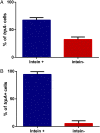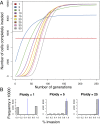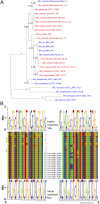Impact of a homing intein on recombination frequency and organismal fitness
- PMID: 27462108
- PMCID: PMC4987785
- DOI: 10.1073/pnas.1606416113
Impact of a homing intein on recombination frequency and organismal fitness
Abstract
Inteins are parasitic genetic elements that excise themselves at the protein level by self-splicing, allowing the formation of functional, nondisrupted proteins. Many inteins contain a homing endonuclease (HEN) domain and rely on its activity for horizontal propagation. However, successful invasion of an entire population will make this activity redundant, and the HEN domain is expected to degenerate quickly under these conditions. Several theories have been proposed for the continued existence of the both active HEN and noninvaded alleles within a population. However, to date, these models were not directly tested experimentally. Using the natural cell fusion ability of the halophilic archaeon Haloferax volcanii we were able to examine this question in vivo, by mating polB intein-positive [insertion site c in the gene encoding DNA polymerase B (polB-c)] and intein-negative cells and examining the dispersal efficiency of this intein in a natural, polyploid population. Through competition between otherwise isogenic intein-positive and intein-negative strains we determined a surprisingly high fitness cost of over 7% for the polB-c intein. Our laboratory culture experiments and samples taken from Israel's Mediterranean coastline show that the polB-c inteins do not efficiently take over an inteinless population through mating, even under ideal conditions. The presence of the HEN/intein promoted recombination when intein-positive and intein-negative cells were mated. Increased recombination due to HEN activity contributes not only to intein dissemination but also to variation at the population level because recombination tracts during repair extend substantially from the homing site.
Keywords: homing cycle; homing endonuclease; horizontal gene transfer; intein; selfish genetic elements.
Conflict of interest statement
The authors declare no conflict of interest.
Figures










References
Publication types
MeSH terms
Substances
LinkOut - more resources
Full Text Sources
Other Literature Sources

